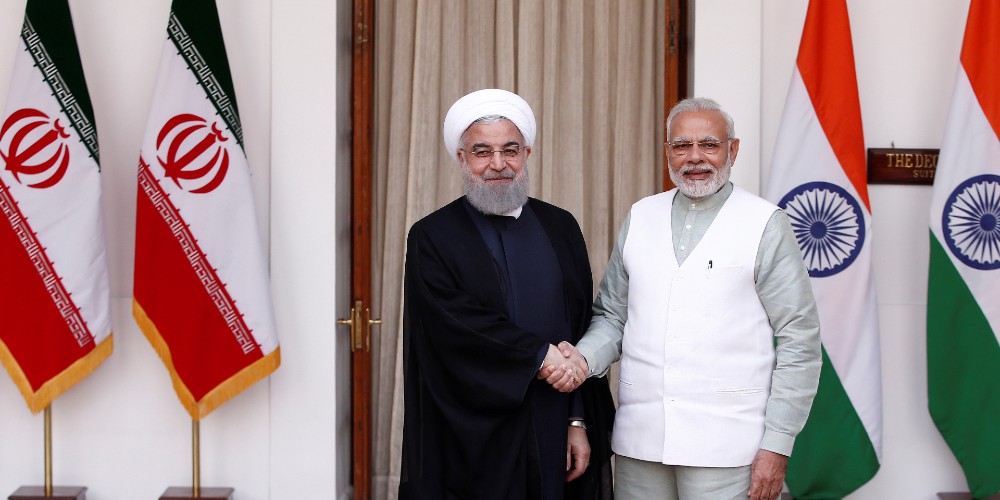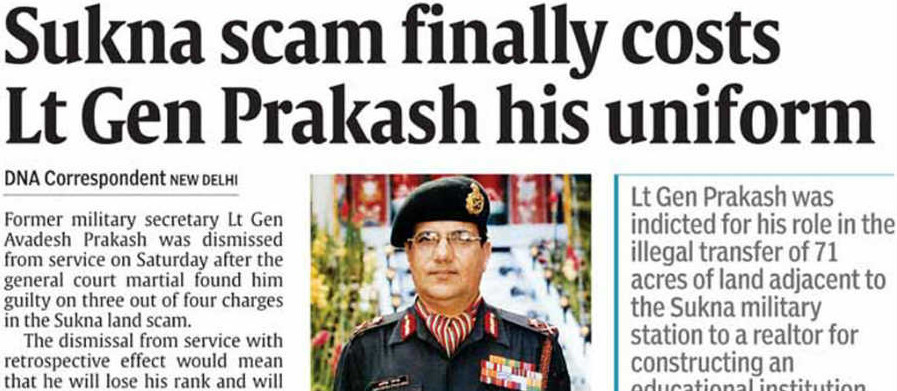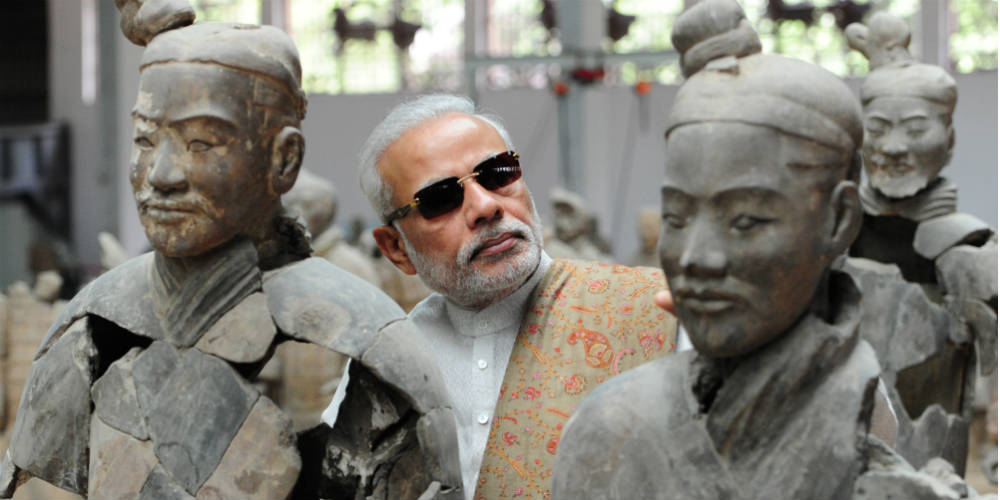BY RSN SINGH
The Iranian nuclear deal painstakingly scripted by Obama for all practices is, off. The deal came into effect on 18 October 2015 and was implemented on 16 January 2016. The deal as part of Joint Comprehensive Plan Of Action (JCPOA) involving P 5+1 countries stipulated that Iran would reduce its nuclear stockpile from 10,000 kgs to 300 kgs, centrifuges from 20,000 to 6,104 and barred the construction of a heavy water reactor for next 15 years.
Why is Trump against?
Trump is convinced that the deal does not defang or deter Iran from being anti-Israel, anti-US and anti-Saudi spearhead in the region. The Trump administration believes $ 150 billion sanction relief enabled Iran to fund terrorist organizations like Hezbollah and Hamas.
The current US dispensation feels that the nuclear deal which involved Iran selling its enriched uranium and heavy water, beyond the specified stipulation to Russia and Oman respectively, actually amounts to according respectability to its nuclear weapons programme. It also convinced that the latitude of specified time period for the operation of the deal, i.e. the sunset clause, amounts to legitimization of the programme. The very purpose of the deal was to insulate Israel and other Gulf states from the hostile attitude, agenda and actions of Iran. The deal has in no way restricted or sobered Iran from using its leverages against Israel and Saudi Arabia.
The Houthi rebels spurred by Iran continue to attack Saudi Arabia. The Palestinians and the Hezbollah in Lebanon continue to receive lethal arsenals and funds from Iran. The nuclear deal therefore has not addressed the grave security threats posed by Iran to any of its sworn enemies. Trump is therefore right in saying that the deal should have been comprehensive to include missiles as well. The Shia fundamentalist regime of Iran continues to spit fire against Israel, challenging its very existence. It continues to be rabidly anti-Zionist. Confronted with existential threat posed by Iran, Netanyahu has every right to militarily preempt Iran from acquiring nuclear weapons capability. For its existential security Israel cannot depend on US or any other country. It has to rely on own perceptions, Intelligence and means.
Clash of religions, faiths and ethnicities
Since the so called Islamic Revolution of 1979, Iran is a theocratic country guided by clerics (Guardian Council) and run by politicians in what can be described as controlled democracy. In West Asia the hate-Jew or hate-Israel campaign of the ruling clerics could not be moderated over the years. Why should India get sucked in this theocratic war? The bitter truth is that all through history old religions have been in contest with new faiths and that has often been bloody. It is also true that the new faiths or those who pretend to be one, are basically offshoots of the old faiths,because nothing can be born in a vacuum. Because of their depth and ageless evolutionary process, old religions or primordial religions do not die. This applies to Iran as well.
Before the 16th century, Iran was a Sunni country. Before that it was a Zoroastrian country. It was Shah Ismail-I of Safavid dynasty, who turned the entire country into Shia faith in the beginning of the century. He unleashed unrelenting violence against the Sunnis, destroyed their mosques and seized their properties. He introduced a ritual of cursing the first three caliphs, i.e. Abu Bakar, Umar and Uthaman. The Sunni Ulemas were given the choice either to convert or to face death. More than religious, this was a move predicated on strategic and geopolitical exigencies.
The Ottoman Empire in the West and Uzbeks in the Northeast were enemies of Iran and both were Sunnis. Ismail Shah was concerned that the Sunnis within Iran could act as fifth columnists at the behest of these inimical powers. He wanted to ensure that his subjects are loyal to the state and the institutions. Ismail-I captured Armenia, Azerbaijan, parts of Russia and Herat in present day Afghanistan. The people of these territories were also converted to Shia faith.
Religious faith therefore is not cast on stone and is liable to shifts, which may occur at long intervals but is certainly not permanent. As per many observers, who have travelled within Iran, there is imperceptible shift away from the present religious dispensation.
Emphasis on Pre-Islamic identity
Increasingly there is emphasis on Persian rather than Islamic identity. This is significant given the fact that the Ayatollah had termed the political revolution of 1979 as Islamic Revolution. In response to Trump’s recent warning to Iran that threatening US will lead to Iran’s ‘official end’, Iran’s foreign minister Javad Zarif tweeted: “Trump hopes to achieve what Alexander, Genghis & other aggressors failed to do”. He further tweeted: “Never threaten an Iranian”. The emphasis is clearly on pre-Islamic past.
The Iranians have always been nostalgic about their pre-Islamic eminence and achievements. In 2010, the then President Ahmadinejad arranged to bring the 6th century BC, Cyrus Cylinder from the British museum on loan. The Cylinder dates back to the time when the Persian ruler Cyrus captured Babylon. This Cylinder was fashioned to disseminate the new ruler’s ideas and programs to the Babylonians. The Iranians believe that this Cylinder is the first document of human rights. It was used as a psychological tool to mobilize Muslims and non-Muslims of Iran during the Iran-Iraq war (1980-1988).
It may be mentioned that at least 10 percent of population of Iran follows the Sunni faith and one percent are adherents of the Bahai religion. In actuality, many Iranians who overtly profess to be Shias have not abandoned Zoroastrianism. Also Iran is host to many ethnic groups, i.e. Persian (52%), Azeri (25%), Kurd (7.5%), Arab (3.5%), Gilaki (7.5%), Lur (2%), and Turkmen (2%).
When the Cyrus Cylinder was brought to Iran in 2010, it received one million visitors. There is a sizeable constituency in Iran, who are nationalists rather than Islamists. The nationalists take pride in pre-Islamic past and consider Islam to be a foreign religion imposed by the Arabs. In this regard, an article by Brig Xerxes Adrianwala” A Parsi Visits the Land of His Fathers and Finds a Different Islamic Republic’’, published (02.06.2016) in Daily O is revealing. He writes:
“I went to Iran for first time in 1990. I was observer with UN and the aftermath of the revolution and the effects of recent Iran-Iraq was evident everywhere….. I am a Parsi Zoroastrian and the Iranian establishment viewed me with suspicion, they wondered if the Indian government sent me to subvert the local Zoroastrians. A few Zoroastrians…, would meet me often furtively, as the risk of being interrogated was too high. Twenty six years later the environment has changed completely. Zoroastrians are respected, their places of worship flourish and the earlier general air of furtiveness has replaced by quiet, unobtrusive dignity.I was told that there are many more Zoroastrians now than twenty or so years earlier. Possibly more of them are declaring their faith? Or is it that some Iranians are reverting to their origins, or may be bit of both.”
Nervous clerics have parallel Armed Forces
It is not that the clerics who rule Iran are not aware of this undercurrent. It is to protect or impose their Islamic beliefs and agendas that they created the Islamic Revolutionary Guards Corps (IRGC). The IRGC is a state within state to ensure that the clerics regime is protected and Iran does not relapse into old Persian civilizational status by abandoning of diluting Shia Islam. The IRGC was created in 1979 by a decree issued by Khomeini. Following the Revolution, in the new religious dispensation’s perception, the own armed forces of Iran posed serious threat. Therefore the IRGC was created as an overarching counter balance. The organization has acted as eyes, ears and of course ruthless hands of the regime. During the infancy years, the Palestinian Liberation Organization (PLO) provided training to IRGC personnel. Following the Israeli invasion of Lebanon in 1982, the Islamic regime in Iran deployed 1000 IRGC personnel in support of Islamic Amal, which sought to turn Lebanon into an Islamic state.
The armed forces of Iran has nearly 5,40,000 personnel but the most trusted and elitist parallel force is the IRGC, which has about 120,000 personnel, i.e. 100,000 ground forces and 20,000 naval forces, which include 5,000 strong marine brigade. The IRGC navy operates some 10 Houdong patrol vessel equipped with C-802 missiles. It has a separate air force wing whose details are not known. It is believed to possess some ballistic missiles in its arsenal.
In April this year, Trump designated the IRGC as a ‘terrorist organization’. Thus, the US has equated IRGC with Al-Qaeda, the Islamic State and Boko Haram. Designating IRGC a terrorist organization enables the US to use the law for application of military force against Iran. This law was passed in 2001, by which the US President has given the orders for invasion of Afghanistan and Iraq. The Commander of the IRGC has warned that in case Iran is not allowed to ship its oil, the Strait of Hormuz will be closed, which would reduce the global supply of oil by 25%.
Need for Indian brand of Islam
In contemporary West Asia, conflict of ethnicity is much more vicious than conflict between Islamic Sects. Arabs versus Iranians is much dangerous rivalry than Shia versus Sunnis. In India, there are no bitter issues involving ethnicity amongst Muslims since majority of them are Hindu converts. Yet for Islamic percepts and narratives, they take cue from Saudi Arabia and Iran. The people of Iran are emotional about Cyrus Cylinder, they take pride in their pre-Islamic ancestors and civilization, but the Muslims in India have no such sense of ownership rather they have the tendency to run away from their past. The Muslims of the Subcontinent do not consider Chandragupt Maurya, Samudragupt or Shankracharya as their heritage. They justify the destruction of Nalanda University. While the Iranians take pride in King Cyrus, the Muslims in India disown King Porus. While President Rouhani talks of the defeat inflicted by the Persians on Alexander, the Indian Muslims are hardly aware as to how Porus compelled Alexander to turn back from the gates of India.
Thus, for the sake of nation-building, the creation and evolution of Indian brand of Islam is a dying imperative. Also the end of Cleric rule in Iran will have a very positive impact on India.
India’s strategic imperatives
Yes, the reality is that India is one of the largest importers of oil and Iranian oil constitutes one-third of our imports. India accounted for 18 percent of Iran’s global oil sales. In comparison, China accounts for 24 percent. However, it is also true that Iraq and Saudi Arabia are second and third largest exporters respectively.
Coinciding with the advent of the current NDA dispensation and owing to extenuating geopolitical environment, following the Iranian nuclear deal, also referred to as Joint Comprehensive Plan Of Action (JCPOA) of the P 5+1 countries, the Iranian crude supplies increased from nearly 11 million tonnes to 27 million tonnes. Data suggests that between April 2018 and January 2019, India imported $97 billion worth of petroleum products of which $ 10.9 billion worth was from Iran. With fresh sanctions imposed by the US, India will have to make major adjustments for its energy security.
In the Middle-East, the US is guided by the imperatives of ‘Oil Industry’ and pressures of the Jewish lobby. US therefore has heavy stakes in the Shia-Sunni fissures and ethnic divides in the region. The Shia-Sunni divide as such impinges on the territorial security of Europe and Israel, more so on the later. India too is affected by this divide but in a different way.
The life of the Iranian nuclear deal was about two years. Obama did the deal and Trump has killed it. The abrogation of the deal indeed impacts on India and Indian policy on West Asia. Indeed, Indian diplomacy deserves credit for fine balancing between three protagonists in the region, i.e. Israel, Saudi Arabia and Iran. Nevertheless, it is also a reality that the persuasion of nuclear weapons programme with Shia missionary zeal is dangerous for not only the region but the globe as well. In terms of physical security and energy security, India will be impacted the most if Iran is successful in its clandestine nuclear weapons programme. Such programmes, which are pursued with missionary fervor and conviction are never abandoned, least by any deal. Pakistan in this regard is a flagrant example. Trump is only being realistic, hence cannot be faulted.
The US has deployed its aircraft carrier ‘Abraham Lincoln’ and B-52 bombers in the Gulf Region as part of strategic and military posturing against Iran. There are also reports about additional troops induction by the US. Such massive deployments are not without reckoning clear end objectives. Meanwhile, the situation in the Gulf region is becoming tense. Four oil tankers, two belonging to Saudi Arabia were recently targeted. There have been reports of drone attacks on Saudi oil facilities from Yemen.
The CPEC factor
The developments in the Gulf region are influenced by the CPEC factor or the China factor as well. In the area around the Gwadar in Pakistan, there have been two attacks within one month. Recently, five personnel were killed in a hotel and on 18 April, 14 security personnel were off loaded from a bus and killed in cold blood on the highway. These attacks are attributed to the Baluchistan Liberation Army (BLA). Earlier in November 2018, the Chinese Consulate in Karachi was attacked. In a video message, the BLA has decried the CPEC as a tool of exploitation of Baluchistan and its people. The CPEC is bound to be fiercely contested overtly or covertly by established powers. The Persian Gulf is already a tense strategic arena and the inroad by a new player, China, in the region is fraught with dangerous imponderables.
Iran is not only a player in the oil market, but also considers itself the leader of the Shias, in fact, the entire Muslims in West Asia. It considers itself the Islamic spearhead against anti-Zionism. It considers US as the rival camp in West Asia. Under such circumstances, nuclear Iran is dangerous for the Americans, the Israelis and the Gulf Sheikhdoms. If the Gwadar venture through the CPEC succeeds and Iran goes nuclear, that would be the end of US strategic dominance in the region. Therefore, before China turns Iran into a rogue nuclear state on lines of Pakistan and North Korea, the US is bound to act.
Conclusion
Khamenei, the supreme leader of Iran, is in his 80s and is suffering from cancer. His death would create a vacuum, therefore the US military is in position. India must take a long term position and that is to keep the civilizational ties intact with the people of Iran, rather than the regime of clerics, which is supported not by the people but the IRGC. Any regime that is radical and uses a parallel force for its perpetuity cannot be trusted with nuclear weapons. India’s experience with Pakistan has been that nuclear weapons provide the shadow for terrorism.
(RSN Singh is a former military intelligence officer who later served in the Research & Analysis Wing. The author of two books: Asian Strategic and Military Perspective and Military Factor in Pakistan, he is also a Guest Blogger with Canary Trap. The opinions expressed by the author and those providing comments are theirs alone, and do not reflect the opinions of Canary Trap or any employee thereof)


